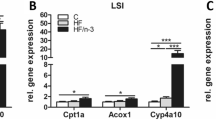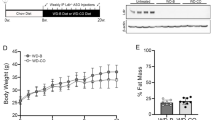Abstract
Considerable research has focused upon the role of linoleic acid (LNA; 18:2n-6) as a competitive inhibitor of α-linolenic (ALA; 18:3n-3) metabolism; however, little data exist as to the impact of saturated fatty acids (SFA) and monounsaturated fatty acids (MUFA) on ALA metabolism. We tested the hypothesis that a high SFA diet, compared to a high MUFA (oleic acid 18:1n-9) diet, reduces ALA conversion to long chain n-3 fatty acids. Mice were fed for 12 weeks on three diets: (1) a control, 16 % fat energy diet consisting of similar levels of SFA and MUFA (2) a 50 % fat energy high MUFA energy diet (35 % MUFA and 7 % SFA) or (3) a 50 % fat energy, high SFA energy diet (34 % SFA, 8 % MUFA). ALA and LNA content remained constant. Analysis of hepatic lipids demonstrated a selective reduction (40 %) in ALA but not LNA and a 35 % reduction in eicosapentaenoic acid (EPA; 20:5n-3) in the high MUFA mice compared to the other groups. Lower content of ALA was reflected in the neutral lipid fraction, while smaller levels of phospholipid esterified EPA and docosapentaenoic acid (DPA; 22:5n-3) were evident. Docosahexaenoic acid (DHA; 22:6n-3) content was elevated by the high SFA diet. Expression of Fads1 (Δ5 desaturase) and Fads2 (Δ6 desaturase) was elevated by the high MUFA and reduced by the high SFA diet. These data indicate that a high MUFA diet, but not a high SFA diet, reduces ALA metabolism and point to selective hepatic disposition of ALA versus LNA.



Similar content being viewed by others
References
Calder PC (2015) Functional roles of fatty acids and their effects on human health. JPEN J Parenter Enteral Nutr. doi:10.1177/0148607115595980
Barcelo-Coblijn G, Murphy EJ (2009) α-Linolenic acid and its conversion to longer chain n-3 fatty acids: benefits for human health and a role in maintaining tissue n-3 fatty acid levels. Prog Lipid Res 48:355–374
Wood KE, Mantzioris E, Gibson RA, Ramsden CE, Muhlhausler BS (2015) The effect of modifying dietary LA and ALA intakes on omega-3 long chain polyunsaturated fatty acid (n-3 LCPUFA) status in human adults: a systematic review and commentary. Prostaglandins Leukot Essent Fatty Acids 95:47–55. doi:10.1016/j.plefa.2015.1001.1001
Domenichiello AF, Kitson AP, Bazinet RP (2015) Is docosahexaenoic acid synthesis from α-linolenic acid sufficient to supply the adult brain? Prog Lipid Res 59:54–66. doi:10.1016/j.plipres.2015.1004.1002
Sanders TA (2009) DHA status of vegetarians. Prostaglandins Leukot Essent Fatty Acids 81:137–141
Jahns L, Raatz SK, Johnson LK, Kranz S, Silverstein JT, Picklo MJ (2014) Intake of seafood in the US varies by age, income, and education level but not by race-ethnicity. Nutrients 6:6060–6075. doi:10.3390/nu6126060
Ogden CL, Carroll MD, Kit BK, Flegal KM (2014) Prevalence of childhood and adult obesity in the United States, 2011–2012. JAMA 311:806–814. doi:10.1001/jama.2014.1732
Ng M, Fleming T, Robinson M, Thomson B, Graetz N, Margono C, Mullany EC, Biryukov S, Abbafati C, Abera SF et al (2014) Global, regional, and national prevalence of overweight and obesity in children and adults during 1980–2013: a systematic analysis for the Global Burden of Disease Study 2013. Lancet 384:766–781
Siddiqui ST, Kandala NB, Stranges S (2015) Urbanisation and geographic variation of overweight and obesity in India: a cross-sectional analysis of the Indian Demographic Health Survey 2005–2006. Int J Public Health 22:22
Wang Y, Botolin D, Xu J, Christian B, Mitchell E, Jayaprakasam B, Nair MG, Peters JM, Busik JV, Olson LK et al (2006) Regulation of hepatic fatty acid elongase and desaturase expression in diabetes and obesity. J Lipid Res 47:2028–2041
Araya J, Rodrigo R, Pettinelli P, Araya AV, Poniachik J, Videla LA (2010) Decreased liver fatty acid Δ-6 and Δ-5 desaturase activity in obese patients. Obesity (Silver Spring) 18:1460–1463
Mayneris-Perxachs J, Sala-Vila A, Chisaguano M, Castellote AI, Estruch R, Covas MI, Fito M, Salas-Salvado J, Martinez-Gonzalez MA, Lamuela-Raventos R et al (2014) Effects of 1-year intervention with a Mediterranean diet on plasma fatty acid composition and metabolic syndrome in a population at high cardiovascular risk. PLoS ONE 9:e85202. doi:10.81371/journal.pone.0085202
Dall TM, Fulgoni VL 3rd, Zhang Y, Reimers KJ, Packard PT, Astwood JD (2009) Potential health benefits and medical cost savings from calorie, sodium, and saturated fat reductions in the American diet. Am J Health Promot 23:412–422. doi:10.4278/ajhp.080930-QUAN-080226
Tande DL, Magel R, Strand BN (2010) Healthy Eating Index and abdominal obesity. Public Health Nutr 13:208–214. doi:10.1017/S1368980009990723
Buettner R, Parhofer KG, Woenckhaus M, Wrede CE, Kunz-Schughart LA, Scholmerich J, Bollheimer LC (2006) Defining high-fat-diet rat models: metabolic and molecular effects of different fat types. J Mol Endocrinol 36:485–501
Buettner R, Scholmerich J, Bollheimer LC (2007) High-fat diets: modeling the metabolic disorders of human obesity in rodents. Obesity (Silver Spring) 15:798–808
Catta-Preta M, Martins MA, Cunha Brunini TM, Mendes-Ribeiro AC, Mandarim-de-Lacerda CA, Aguila MB (2012) Modulation of cytokines, resistin, and distribution of adipose tissue in C57BL/6 mice by different high-fat diets. Nutrition 28:212–219. doi:10.1016/j.nut.2011.05.011
Hariri N, Gougeon R, Thibault L (2010) A highly saturated fat-rich diet is more obesogenic than diets with lower saturated fat content. Nutr Res 30:632–643. doi:10.1016/j.nutres.2010.09.003
Menard CR, Goodman KJ, Corso TN, Brenna JT, Cunnane SC (1998) Recycling of carbon into lipids synthesized de novo is a quantitatively important pathway of α-[U-13C]linolenate utilization in the developing rat brain. J Neurochem 71:2151–2158
Brenna JT (2002) Efficiency of conversion of α-linolenic acid to long chain n-3 fatty acids in man. Curr Opin Clin Nutr Metab Care 5:127–132
DeLany JP, Windhauser MM, Champagne CM, Bray GA (2000) Differential oxidation of individual dietary fatty acids in humans. Am J Clin Nutr 72:905–911
Gillingham LG, Harding SV, Rideout TC, Yurkova N, Cunnane SC, Eck PK, Jones PJ (2013) Dietary oils and FADS1–FADS2 genetic variants modulate [13C]α-linolenic acid metabolism and plasma fatty acid composition. Am J Clin Nutr 97:195–207
Goyens PL, Spilker ME, Zock PL, Katan MB, Mensink RP (2006) Conversion of α-linolenic acid in humans is influenced by the absolute amounts of α-linolenic acid and linoleic acid in the diet and not by their ratio. Am J Clin Nutr 84:44–53
McCloy U, Ryan MA, Pencharz PB, Ross RJ, Cunnane SC (2004) A comparison of the metabolism of eighteen-carbon 13C-unsaturated fatty acids in healthy women. J Lipid Res 45:474–485
Leyton J, Drury PJ, Crawford MA (1987) Differential oxidation of saturated and unsaturated fatty acids in vivo in the rat. Br J Nutr 57:383–393
Burdge GC, Wootton SA (2003) Conversion of α-linolenic acid to palmitic, palmitoleic, stearic and oleic acids in men and women. Prostaglandins Leukot Essent Fatty Acids 69:283–290
Cunnane SC, Ryan MA, Lin YH, Lim SY, Salem N Jr (2006) Suckling rats actively recycle carbon from α-linolenate into newly synthesized lipids even during extreme dietary deficiency of n-3 polyunsaturates. Pediatr Res 59:107–110
Taha AY, Ryan MA, Cunnane SC (2005) Despite transient ketosis, the classic high-fat ketogenic diet induces marked changes in fatty acid metabolism in rats. Metabolism 54:1127–1132
Taha AY, Ryan MA, Cunnane SC (2006) Markedly raised intake of saturated and monounsaturated fatty acids in rats on a high-fat ketogenic diet does not inhibit carbon recycling of 13C-α-linolenate. Lipids 41:933–935
Burdge GC, Finnegan YE, Minihane AM, Williams CM, Wootton SA (2003) Effect of altered dietary n-3 fatty acid intake upon plasma lipid fatty acid composition, conversion of [13C]α-linolenic acid to longer-chain fatty acids and partitioning towards β-oxidation in older men. Br J Nutr 90:311–321
Pawlosky RJ, Hibbeln JR, Novotny JA, Salem N Jr (2001) Physiological compartmental analysis of α-linolenic acid metabolism in adult humans. J Lipid Res 42:1257–1265
Tu WC, Cook-Johnson RJ, James MJ, Muhlhausler BS, Gibson RA (2010) Omega-3 long chain fatty acid synthesis is regulated more by substrate levels than gene expression. Prostaglandins Leukot Essent Fatty Acids 83:61–68
Blank C, Neumann MA, Makrides M, Gibson RA (2002) Optimizing DHA levels in piglets by lowering the linoleic acid to α-linolenic acid ratio. J Lipid Res 43:1537–1543
Peifer JJ, Holman RT (1959) Effect of saturated fat upon essential fatty acid metabolism of the rat. J Nutr 68:155–168
Wilson RF (2012) The role of genomics and biotechnology in achieving global food security for high-oleic vegetable oil. J Oleo Sci 61:357–367
Dietary Guidelines for Americans (2010) U.S. Department of Agriculture and U.S. Department of Health and Human Services, Washington, DC
Reeves PG, Nielsen FH, Fahey GC Jr (1993) AIN-93 purified diets for laboratory rodents: final report of the American Institute of Nutrition ad hoc writing committee on the reformulation of the AIN-76A rodent diet. J Nutr 123:1939–1951
Golovko MY, Hovda JT, Cai ZJ, Craigen WJ, Murphy EJ (2005) Tissue-dependent alterations in lipid mass in mice lacking glycerol kinase. Lipids 40:287–293
Masood A, Stark KD, Salem N Jr (2005) A simplified and efficient method for the analysis of fatty acid methyl esters suitable for large clinical studies. J Lipid Res 46:2299–2305
Schmittgen TD, Livak KJ (2008) Analyzing real-time PCR data by the comparative CT method. Nat Protoc 3:1101–1108
Cedernaes J, Alsio J, Vastermark A, Riserus U, Schioth HB (2013) Adipose tissue stearoyl-CoA desaturase 1 index is increased and linoleic acid is decreased in obesity-prone rats fed a high-fat diet. Lipids Health Dis 12:2
Jan S, Guillou H, D’Andrea S, Daval S, Bouriel M, Rioux V, Legrand P (2004) Myristic acid increases Δ6-desaturase activity in cultured rat hepatocytes. Reprod Nutr Dev 44:131–140
Rioux V, Catheline D, Bouriel M, Legrand P (2005) Dietary myristic acid at physiologically relevant levels increases the tissue content of C20:5 n-3 and C20:3 n-6 in the rat. Reprod Nutr Dev 45:599–612
Fu Z, Sinclair AJ (2000) Novel pathway of metabolism of α-linolenic acid in the guinea pig. Pediatr Res 47:414–417
Wang Y, Botolin D, Christian B, Busik J, Xu J, Jump DB (2005) Tissue-specific, nutritional, and developmental regulation of rat fatty acid elongases. J Lipid Res 46:706–715
Raatz SK, Bibus D, Thomas W, Kris-Etherton P (2001) Total fat intake modifies plasma fatty acid composition in humans. J Nutr 131:231–234
Bjursell M, Xu X, Admyre T, Bottcher G, Lundin S, Nilsson R, Stone VM, Morgan NG, Lam YY, Storlien LH et al (2014) The beneficial effects of n-3 polyunsaturated fatty acids on diet induced obesity and impaired glucose control do not require Gpr120. PLoS ONE 9:e114942. doi:10.1371/journal.pone.0114942
Murali G, Milne GL, Webb CD, Stewart AB, McMillan RP, Lyle BC, Hulver MW, Saraswathi V (2012) Fish oil and indomethacin in combination potently reduce dyslipidemia and hepatic steatosis in LDLR(−/−) mice. J Lipid Res 53:2186–2197. doi:10.1194/jlr.M029843 (Epub 022012 Jul 029829)
Saraswathi V, Gao L, Morrow JD, Chait A, Niswender KD, Hasty AH (2007) Fish oil increases cholesterol storage in white adipose tissue with concomitant decreases in inflammation, hepatic steatosis, and atherosclerosis in mice. J Nutr 137:1776–1782
What We Eat in America (2011–2012) National Health and Nutrition Examination Survey. NHANES 2011–2012. Centers for Disease Control and Prevention; National Center for Health Statistics. http://www.ars.usda.gov/SP2UserFiles/Place/80400530/pdf/1112/Table_1_NIN_GEN_11.pdf
Oilseeds: World markets and trade, 2015, United States Department of Agriculture, Foreign Agricultural Service
Acknowledgments
The authors thank Joseph Idso, Deborah Johnson, Brian Gregoire, and the GFHRNC vivarium staff for their excellent technical assistance. Funding was provided through USDA-ARS Project 3062-51000-053-00D (MJP). The U.S. Department of Agriculture, Agricultural Research Service, Plains Area is an equal opportunity/affirmative action employers and all agency services are available without discrimination. Mention of trade names or commercial products in this article is solely for providing specific information and does not imply recommendation or endorsement by the U.S. Department of Agriculture.
Author information
Authors and Affiliations
Corresponding author
Additional information
Paper is part of Northern Great Plains Lipid Conference special/topical collection.
About this article
Cite this article
Picklo, M.J., Murphy, E.J. A High-Fat, High-Oleic Diet, But Not a High-Fat, Saturated Diet, Reduces Hepatic α-Linolenic Acid and Eicosapentaenoic Acid Content in Mice. Lipids 51, 537–547 (2016). https://doi.org/10.1007/s11745-015-4106-9
Received:
Accepted:
Published:
Issue Date:
DOI: https://doi.org/10.1007/s11745-015-4106-9




